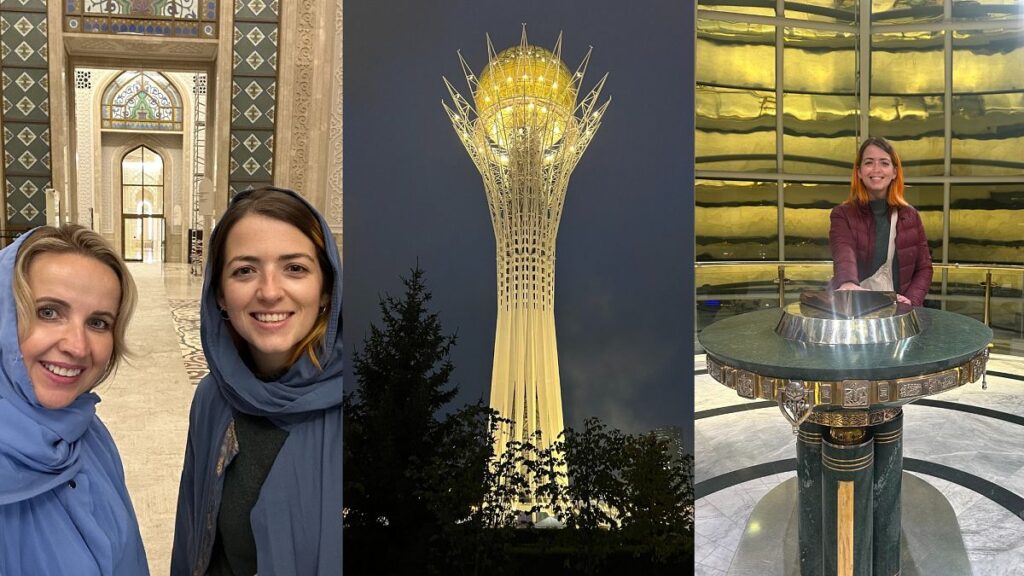Foodies can feast on meat dishes and local chocolate at wallet-friendly prices.
Whilst Kazakhstan’s former capital Almaty is often known as the city of culture, Astana is still well worth a visit for stunning architecture, friendly locals and a taste of nomadic culture.
Unlike many city breaks, an Astana itinerary won’t be packed with art galleries. Thanks to Kazakhstan’s nomadic culture, the performing arts prevailed over physical. This has given rise to a variety of drama, ballet and opera theatres.
I spent six days exploring the city and here are my top picks of things to do.
The best time of year to visit Kazakhstan: Plan carefully if you don’t like the cold
Astana is the second coldest capital in the world, just behind Mongolia’s Ulaanbaatar. The city’s Ishim river is usually frozen solid from mid-November to early April.
Some travellers love a cold city break. But if you prefer to be warmer, head to Kazakhstan during the European summer when the average temperature is around 30C.
I visited in September and the temperature was around 19C. When the sun shone it brought with it lovely warmth but the light breeze made it pleasant for exploring. Make sure you pack layers for the morning and evening.
Average costs of a trip and how to get to Kazakhstan
For Europeans travelling to Kazakhstan, the exchange rate is very favourable and so, apart from fancy wine in very high end restaurants, Astana is affordable. An average two course meal with a drink will cost around €20-25 per person.
Air Astana offers almost-daily direct flights between Frankfurt and Astana, as well as two overnight flights from London Heathrow to Astana via Almaty. There also are easy connections up to three times a week from Amsterdam to Astana via Atyrau
A quick practical note: Kazakhstan uses standard European plug sockets (C, E, F) so no need to pack an adapter.
The Grand Mosque: for impressive architecture
I’m not religious but I was still wowed by the architecture and sheer scale of Astana’s Grand Mosque, the largest in Central Asia.
Sitting on the edge of the city, the dramatic white, gold and turquoise building cuts a stunning silhouette. The inside is no less impressive.
Visitors must remove their shoes before entering and gowns are provided for women to cover themselves. Make sure you’re not wearing comedy socks as I, unfortunately, was on the day of my visit.
Each room is exquisitely decorated with the men’s prayer room being the most magnificent. Here you can see the world’s largest hand woven carpet with a traditional Kazakh spiral pattern and a wall adorned with the 99 names of Allah glistening in gold. Women can enter this room but some parts are off limits during the prayer sessions which happen five times a day.
Leave time to take the lift up to the top of one of the minarets for great views over the city.
Baiterek: for views across the city
The Baiterek monument (sometimes spelt ‘Bayterek’) is the iconic symbol of Astana. The name means ‘tall poplar tree’ and is inspired by a traditional folktale about a magic bird of happiness who lays her egg on the top of a tree, representing the transfer of Kazakhstan’s capital to Astana in 1997.
I visited in the evening but this isn’t the best time of day – you’ll get much better views from the top of the 105m tall tower during the day. At night the inside lights reflect off the glass so you miss out on some of the view.
There’s a nice photo opportunity thanks to a golden handprint of Nursultan Nazarbayev, the first President of independent Kazakhstan.
Once you’re done in the monument, have a walk around this part of the city, taking in the riverside and park. You’ll be treated to beautiful mosques, theatres and an unusually shaped shopping centre.
Nur Alem Museum of Future Energy: for a family day out
This museum is ideal for a rainy day or if you’ve got kids to entertain. They’ll be kept busy by the interactive displays and adults will enjoy the impressive spherical building that houses it all.
Each of the eight floors is dedicated to a different type of non-fossil fuel energy: solar, wind, hydro, kinetic and so on.
The museum offers free guided tours by request – ask at the ticket office if you’re interested. If you choose to wander around on your own, there are friendly staff on hand to answer your questions.
What is Kazakh food like?
As a vegetarian, Kazakh cuisine isn’t the most herbivore friendly and even as a journalist willing to try all types of traditional dishes to aid my writing, there was still a bit too much horse.
That being said, I recommend being brave and trying all the national delicacies, which the locals are all too delighted to share with you.
‘Beshbarmak’ is a traditional Kazakh dish of horse meat served with a pasta-type noodle and onions. The part of the horse platter that appealed to my tastebuds the most was a slice of sausage with a slightly spiced and smokey flavour.
You’ll find ‘Plov’, though Uzbek in origin, is widely available. It’s a tasty rice dish flavoured with meat, spices, carrots and onions and served on a big sharing platter (imagine a Eurasian paella). An Uzbek friend of mine recommended a restaurant called Altyn Palau for the best in the city.
Vegetarians, fear not, many restaurants serve a hot aubergine salad starter which is delicious and would make for a great main course. There’s always lots of delicious bread to keep you sated. Finally leave space in your luggage for a bar of Kazakh chocolate.
Hannah Brown was a guest of Air Astana.
Read the full article here

